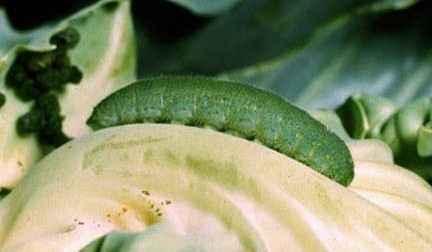|
Imported Cabbageworm
View more pictures: Bing Images Google Images Yahoo Images Common names: Imported Cabbageworm. Scientific name: Pieris rapae. Region: This Caterpillar is found throughout North America and Europe Life cycle: This insect produces two to three generations each year and hibernates in the pupal stage underground. In early spring, these butterflies may be seen depositing their yellow bullet shaped eggs at the base of the leaves of the host plants. The eggs take from four to eight days to hatch, and turn yellow just prior to hatching. Physical Description: This 1 1/4 inch long caterpillar is a velvety smooth, light green with a yellow-green stripe running down its back. The attractive adult moth is white with a black tip on the forewing and three to four black spots. The wingspan is 1 to 2 inches. The eggs are yellow; bullet shaped and ridged, and is laid singly at the base of leaves. Feeding characteristics: This pest attacks cabbage, cauliflower, kale kohlrabi, mustard, radish, and turnip by feeding on the leaves and chewing huge holes in them. It also bores into heads of cabbage. Controls: This Imported Cabbageworm can be attracted to your garden by weeds from the cabbage family, such as, wild radish, wild mustard, and wintercress. Remove these from the vicinity. You can protect your plants by a border of plants that repel the Cabbageworm; these are Onion, Garlic, Tomato, Sage, Tansy, Mint, Southernwood, Nasturtium, Hemp, Hyssop, and Rosemary. Insect predators like various Trichogramma Wasps (commercially available) claim a lot of these pests, but the toxic body contents of the cabbageworm keep birds uninterested. Yellow Jackets have been found to be fond of this caterpillar, so don't discourage them. The Braconid Wasps are also extremely good controlling agents, and can be encouraged by planting Strawberries near your garden. A repellent can be made by combining, in a mixer, Spearmint, Green Onion tops, Garlic, Horseradish root and leaves, Hot Red Peppers, Peppercorns, and soapy water. Canopies made of lightweight polyethylene or nylon netting will keep the moths from laying their eggs on the plants. This won't do any good for surfacing pupae. Bacillus thuringiensis or dusting with sabadilla can be used for larger scale crops and problems. Return from Imported Cabbageworm to Insects I-L Encyclopedia of Garden Insects |
